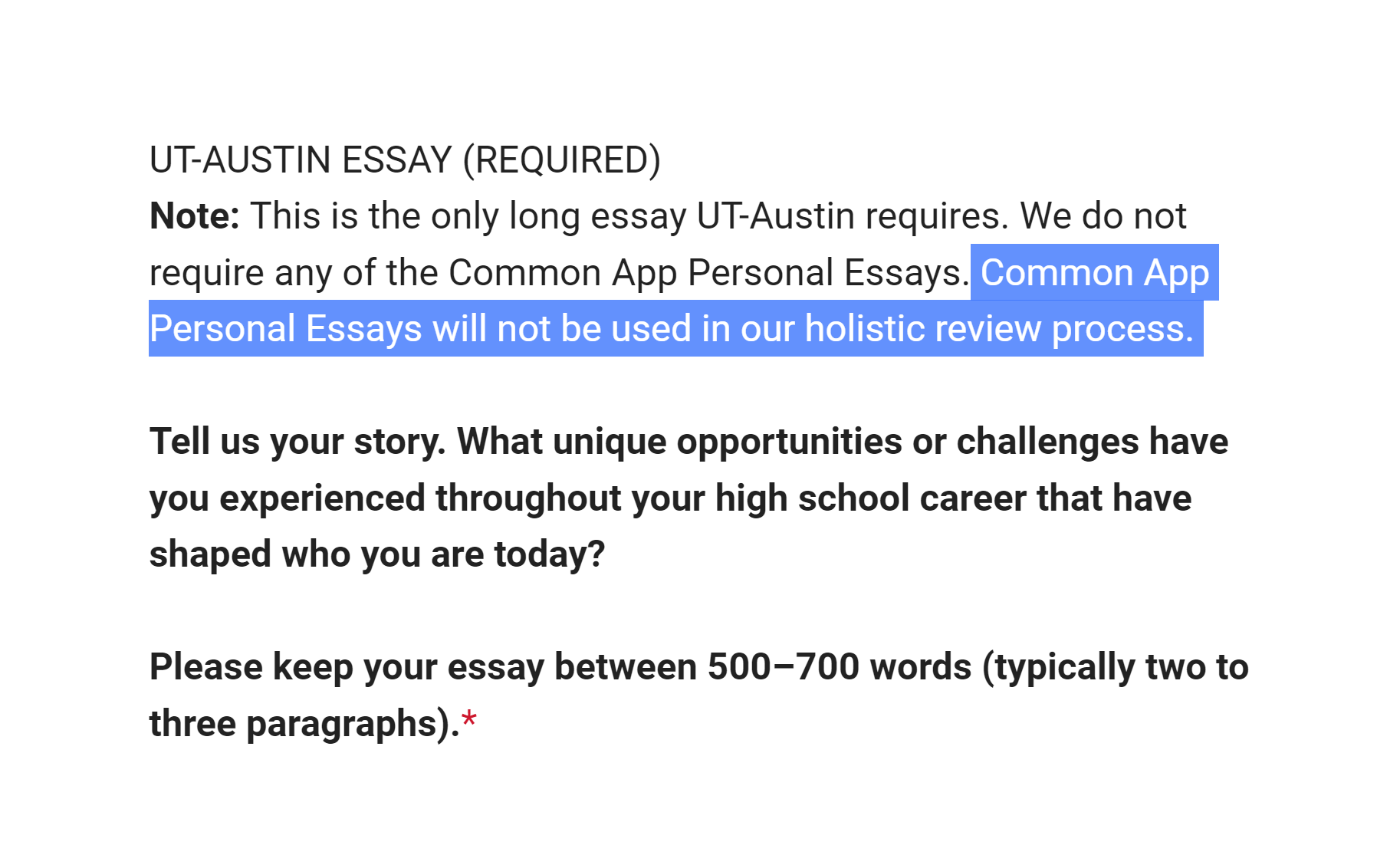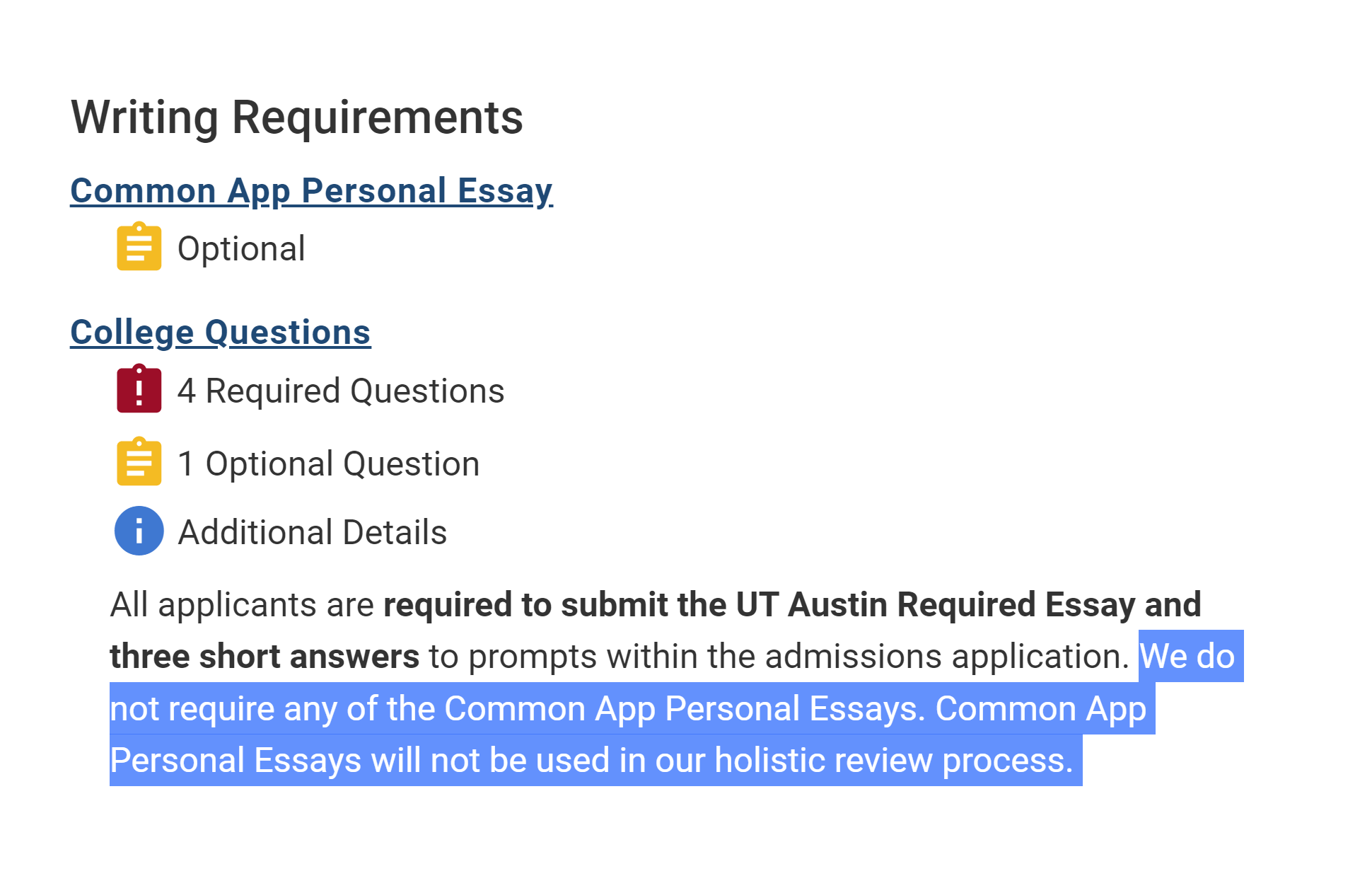UT-Austin and Texas A&M Join the Common Application - Fall 2023 Essay Topics
Hot chocolate at Lake Batur in Kintamani, Bali, Indonesia
UT-Austin and Texas A&M Finally Join the Common Application
A few months ago, the Common Application issued a press release that UT-Austin and Texas A&M would join the Common Application. They were a few remaining flagship/land-grant public institutions that weren’t already one of the 950+ members. The Common Application has always been the most user-friendly (if still flawed) application portal, so this should come as a relief to many families and high school educators.
More than 20 Texas universities are now participating in the Common Application, including UT-Dallas, Texas Tech, University of Houston, UT San Antonio, North Texas, UT Arlington, Baylor, Rice, SMU, TCU, and St. Edwards, among others. UT-Austin and most other Texas universities also remain Test-Optional for Fall 2023.
What Are the Essay and Supplement Requirements for Fall 2023 UT-Austin Applicants?
In classic Texas universities fashion - even by hitching their wagon to the rest of the country in joining the Common App - they are bucking essay requirement trends. There is already a lot of confusion on essay requirements with the app opening today, August 1.
Every Common Application member institution allows applicants to choose one essay among seven topics. This brings consistency to what families and high schools can expect yearly.
However, rather than joining the Common Application essay choice format, UT-Austin and Texas A&M will continue requiring all freshmen applicants to respond to the Apply Texas Essay A Topic “Tell us your story. What unique opportunities or challenges have you experienced throughout your high school career that have shaped who you are today?” (Here are some essay examples)
One FAQ I’m receiving is whether you need to do Essay A AND the Common App prompt. The answer is no. UT and Texas A&M applicants only need to write the single Tell Us Your Story essay. See Common App screenshots below.
In practice, this won’t make much consequential difference for in-state applicants. You can submit your Tell Us Your Story essay for one of the Common Application questions for your other applications. Most college essays are stories anyway. Nevertheless, a centralized application portal with a decentralized system of requirements makes the application process less accessible and more onerous for applicants.
For out-of-state applicants, you should do your UT application and main essay first. Since every Tell Us Your Story essay can fit the Common Application prompts, yet not every “choose one of seven” Common Applications would fit the Tell Us Your Story prompt, the best practice is to do UT first. It’s an “every square is a rectangle but not every rectangle is a square” situation.
I also confirmed with UT staff that the short answer topics will remain the same. However, they will no longer require the fourth Special Circumstances supplement, which was a really problematic requirement last year that I discussed here. It is optional for applicants.
The three UT-Austin short answer topics remain:
UT-Austin Short Answer 1: Why are you interested in the major you indicated as your first-choice major?
UT-Austin Short Answer 2: Describe how your experiences, perspectives, talents, and/or your involvement in leadership activities (at your school, job, community, or within your family) will help you to make an impact both in and out of the classroom while enrolled at UT.
UT-Austin Short Answer 3: The core purpose of The University of Texas at Austin is, "To Transform Lives for the Benefit of Society." Please share how you believe your experience at UT-Austin will prepare you to “Change the World” after you graduate.
Texas A&M requires Essay A and two supplements:
Texas A&M Person Most Impacted: Tell us about the person who has impacted your life and why.
Texas A&M Life Event: Describe a life event which you feel has prepared you to be successful in college.
They also have a few optional scholarship questions that won’t make any difference in you getting aid. They almost only give scholarships to students who demonstrate need or who are national merit semifinalist or finalist. Don’t dwell too much on their scholarship questions.
Here is a post to help answer these prompts.
What Does This Mean for the Apply Texas and the Coalition Application? Which Application Should I Use?
UT-Austin has discontinued its participation in what I see as a failed experiment in the Coalition Application. They only accept Apply Texas and the Common Application moving forward. An answer to an FAQ I regularly receive is that no university will ever give preference to which application you use.
With practically every major Texas university participating in the Common App, I expect few, if any, applicants to use the antiquated and user-unfriendly Apply Texas application. Apply Texas has remained virtually unchanged from when I applied in 2007 even if last year they spiffed up the user interface. The only colleges and universities on Apply Texas only will be small, regional public and private universities and community colleges. Another rare scenario that may arise is if a student has more than 20 schools on the Common App, they may need to use another application to cater to their college list.
The main difference with Common App is that there are hard word limits, meaning you cannot submit a single word over 700 for the main essay or 300 words for each of the short answers. You can also upload your resume and request recommendation letters directly on Common App, a function unavailable on Apply Texas.
So, one small potential advantage in using Apply Texas is utilizing the soft word limit recommendations to provide more essay content and access more word real estate.
Applying for UT Honors on the Common Application
I already anticipate that there will be a lot of confusion about applying for Honors. One reason is that, depending on your first and second choice majors, the Common App populates questions for every program. For example, if you’re a Computer Science applicant who wants to apply for Turing, Common App also shows you the prompts for Human Ecology Honors, Polymathic Scholars.
Many families aren’t familiar that UT doesn’t have a single honors college but many different Departmental and Major-specific, distinctly separate Honors programs. I expect some applicants will write every single essay that populates in the Honors section even if they ren’t eligible for the programs.
Plan II applications need to select it as their SECOND choice major, not their first. There is also a new Plan II prompt:
If you could add another cabinet position to the US President’s White House, what would that position be and why?
Plan II is always known for their quirky prompts. Last year’s asked students to imagine their legacy half a century into the future and how a UT degree helped them achieve their dreams. I don’t have much advice for this one other than to approach it as an “issue of importance.”
Wikipedia has a list of Proposed Departments at the bottom of this page that may help stimulate some ideas.
How Might the Common Application Influence the Admissions Competition?
The short answer is no. I don’t think UT joining the common application will make it more competitive.
It is worth providing a longer answer and short history lesson and a set of hypotheses and questions to evaluate trends over the coming years.
Firstly, I understand the intuition many families will have that “a new application option must surely mean more students will apply.”
I think there is something to this; however, it will be virtually impossible to isolate this variable among the many other trends that are driving application number increases at every top 50 university. So, if UT continues increasing their applicant pool by 5-10% as has been the case since at least 2011, we won’t ever know if it’s because they joined the Common Application. It could be because of other variables like the football team finally playing well, or an economic downturn that makes UT a more affordable/appealing option for Texas families.
Now for a related and brief history lesson. Before and around 2005, it was routine and common for the very top applicants at the best Texas high schools to even bother with applying to UT-Austin. Back then, UT received around 25,000 applicants and admitted two-thirds of them. Many top 20 universities didn’t have any where near as low admissions rates as today. For example, Harvard received 19,000 applications in 2001 compared with 61,000+ for the Class of 2026. Other Ivy League and equivalent universities had admissions rates around 15-20%.
Back then, applicants applied to far fewer universities than today. So, there was less importance for top applicants to have safety schools. Top students routinely omitted their public flagship schools from their lists because there was an excellent chance they’d get into at least one of their top choices. Compared with today, it’s routine for students in the top 1% with perfect SATs to get rejected to all of their reach universities, and occasionally even UT-Austin and equivalent flagship public campuses. As universities become both more expensive and competitive, and as middle class families are increasingly priced out of out-of-state or private options, in-state public universities become a better value.
Starting around a decade ago, coincident with when I worked for UT admissions, top students began applying to UT-Austin at much higher rates. This converges with tuition price increases nationwide, UT’s increasing prominence, success in sports, higher rankings in STEM and Business programs, development of freshmen honors programs, increased marketing and recruitment efforts, a commitment to higher graduation rates and attendant curriculum reforms, and other factors contributed to UT becoming a more appealing option to families who may not have applied in the past.
Almost three times as many students applied to UT in 2022 than fifteen years ago. Nowadays, it is almost unheard of for high-ranking Texas applicants not to apply to UT-Austin and often Texas A&M and UT-Dallas as their safety. Moreover, if I were applying today as an HS student with my credentials, there’s no way I would have gotten into a freshmen honors program (I was in Liberal Arts and Humanities Honors). I discuss just how competitive college admissions has gotten recently, particularly for STEM students, in this recent post.
Here is the point: my hypothesis is that virtually any Texas resident who would have applied in a given cycle recently, similar ones will have done so in subsequent admissions periods. Put another way, I believe that anyone who wants to apply to UT will do so irrespective of UT joining the Common Application. Perhaps a few hundred more students will apply who wouldn’t have otherwise, but in an applicant pool exceeding 70,000, it won’t move the needle much. If UT had joined the Common App in 2005, I can imagine that might have driven more top Texas residents to apply who may have been deterred from creating a cumbersome Apply Texas account.
One consequence of state law mandating that UT-Austin and other Texas publics must enroll 90% of its students as Texas residents means the admissions pool for in-state versus non-Texas residents is completely separate at the university level.
This gets a bit technical, but individual majors like computer science or business or honors programs do not need to maintain the 90:10 ratio of in-versus-out-of-state applicants. These programs routinely enroll 10-20% students who are not Texans. Additionally, OOS applicants tend to apply to UT’s most popular majors in Engineering, Natural Sciences, and McCombs in much higher numbers than their less nationally prestigious programs.
This brings us to an important caveat. Although I don’t expect UT admissions to change much due to the Common App adoption, their participation may attract more OOS applicants who may not have otherwise applied. An increase in OOS applicants should have little to no bearing on in-state students though even if they disproportionately apply to STEM majors. OOS admissions at UT is already ridiculously competitive at around 10%, so it should be considered a reach for virtually every OOS applicant, especially if they want STEM or Business.



